Meteorological Normalisation Using Boosted Regression Trees to Estimate the Impact of COVID-19 Restrictions on Air Quality Levels
Abstract
:1. Introduction
2. Materials and Methods
2.1. Area and Period of Study
2.2. Air Quality and Meteorological Data
2.3. Model Development
2.3.1. Meteorological Normalisation
2.3.2. Emission Pattern Trends Normalisation
2.4. Quantification of Changes
3. Results and Discussion
3.1. Observed Changes
3.2. Estimated Changes
3.3. Analysis of the Traffic Sites
4. Conclusions
Author Contributions
Funding
Institutional Review Board Statement
Informed Consent Statement
Conflicts of Interest
References
- Lu, R.; Zhao, X.; Li, J.; Niu, P.; Yang, B.; Wu, H.; Wang, W.; Song, H.; Huang, B.; Zhu, N.; et al. Genomic characterisation and epidemiology of 2019 novel coronavirus: Implications for virus origins and receptor binding. Lancet 2020, 395, 565–574. [Google Scholar] [CrossRef] [Green Version]
- Nicola, M.; Alsafi, Z.; Sohrabi, C.; Kerwan, A.; Al-Jabir, A.; Iosifidis, C.; Agha, M.; Agha, R. The socio-economic implications of the coronavirus pandemic (COVID-19): A review. Int. J. Surg. 2020, 78, 185–193. [Google Scholar] [CrossRef]
- WHO. Coronavirus Disease (COVID-19) Pandemic. Available online: https://www.who.int/emergencies/diseases/novel-coronavirus-2019 (accessed on 5 July 2021).
- ISCIII. Situación del COVID-19 en España. Available online: https://cnecovid.isciii.es/covid19/ (accessed on 1 July 2021).
- España. Real Decreto 463/2020, de 14 de marzo, por el que se declara el estado de alarma para la gestión de la situación de crisis sanitaria ocasionada por el COVID-19. Boletín Oficial del Estado; núm. 67. Available online: https://www.boe.es/eli/es/rd/2020/03/14/463/con (accessed on 22 April 2021).
- Tobías, A.; Carnerero, C.; Reche, C.; Massagué, J.; Via, M.; Minguillón, M.C.; Alastuey, A.; Querol, X. Changes in air quality during the lockdown in Barcelona (Spain) one month into the SARS-CoV-2 epidemic. Sci. Total Environ. 2020, 726, 138540. [Google Scholar] [CrossRef] [PubMed]
- Martorell-Marugán, J.; Villatoro-García, J.A.; García-Moreno, A.; López-Domínguez, R.; Requena, F.; Merelo, J.J.; Lacasaña, M.; de Dios Luna, J.; Díaz-Mochón, J.J.; Lorente, J.A.; et al. DatAC: A visual analytics platform to explore climate and air quality indicators associated with the COVID-19 pandemic in Spain. Sci. Total Environ. 2021, 750, 141424. [Google Scholar] [CrossRef] [PubMed]
- Gobierno de España, Ministerio de Sanidad. Plan Para la Transición Hacia Una Nueva Normalidad. 2020. Available online: https://www.lamoncloa.gob.es/lang/en/gobierno/councilministers/paginas/2020/20200428council.aspx (accessed on 6 December 2021).
- CNE. COVID-19 en España. Available online: https://cnecovid.isciii.es/ (accessed on 3 July 2021).
- España. Real Decreto 926/2020, de 25 de Octubre, Por El Que Se Declara El Estado de Alarma Para Contener La Propagación de Infecciones Causadas Por el SARS- CoV-2. Boletín Oficial del Estado; núm. 282. Available online: https://www.boe.es/eli/es/rd/2020/10/25/926 (accessed on 24 April 2021).
- Muhammad, S.; Long, X.; Salman, M. COVID-19 pandemic and environmental pollution: A blessing in disguise? Sci. Total Environ. 2020, 728, 138820. [Google Scholar] [CrossRef] [PubMed]
- Viteri, G.; Díaz de Mera, Y.; Rodríguez, A.; Rodríguez, D.; Tajuelo, M.; Escalona, A.; Aranda, A. Impact of SARS-CoV-2 lockdown and de-escalation on air-quality parameters. Chemosphere 2021, 265, 129027. [Google Scholar] [CrossRef]
- Le, T.; Wang, Y.; Liu, L.; Yang, J.; Yung, Y.L.; Li, G.; Seinfeld, J.H. Unexpected air pollution with marked emission reductions during the COVID-19 outbreak in China. Science 2020, 369, 702–706. [Google Scholar] [CrossRef] [PubMed]
- Mesas-Carrascosa, F.J.; Porras, F.P.; Triviño-Tarradas, P.; García-Ferrer, A.; Meroño-Larriva, J.E. Effect of lockdown measures on atmospheric nitrogen dioxide during SARS-CoV-2 in Spain. Remote Sens. 2020, 12, 2210. [Google Scholar] [CrossRef]
- Zhang, Z.; Arshad, A.; Zhang, C.; Hussain, S.; Li, W. Unprecedented temporary reduction in global air pollution associated with COVID-19 forced confinement: A continental and city scale analysis. Remote Sens. 2020, 12, 2420. [Google Scholar] [CrossRef]
- Shi, Z.; Song, C.; Liu, B.; Lu, G.; Xu, J.; Van Vu, T.; Elliott, R.J.R.; Li, W.; Bloss, W.J.; Harrison, R.M. Abrupt but smaller than expected changes in surface air quality attributable to COVID-19 lockdowns. Sci. Adv. 2021, 7, eabd6696. [Google Scholar] [CrossRef]
- Marinello, S.; Butturi, M.A.; Gamberini, R. How changes in human activities during the lockdown impacted air quality parameters: A review. Environ. Prog. Sustain. Energy 2021, 40, 1–18. [Google Scholar] [CrossRef] [PubMed]
- Gkatzelis, G.I.; Gilman, J.B.; Brown, S.S.; Eskes, H.; Gomes, A.R.; Lange, A.C.; McDonald, B.C.; Peischl, J.; Petzold, A.; Thompson, C.R.; et al. The global impacts of COVID-19 lockdowns on urban air pollution: A critical review and recommendations. Elem. Sci. Anthr. 2021, 9. [Google Scholar] [CrossRef]
- Bauwens, M.; Compernolle, S.; Stavrakou, T.; Müller, J.F.; van Gent, J.; Eskes, H.; Levelt, P.F.; van der A, R.; Veefkind, J.P.; Vlietinck, J.; et al. Impact of Coronavirus Outbreak on NO2 Pollution Assessed Using TROPOMI and OMI Observations. Geophys. Res. Lett. 2020, 47, 1–9. [Google Scholar] [CrossRef] [PubMed]
- Mendez-Espinosa, J.F.; Rojas, N.Y.; Vargas, J.; Pachón, J.E.; Belalcazar, L.C.; Ramírez, O. Air quality variations in Northern South America during the COVID-19 lockdown. Sci. Total Environ. 2020, 749, 141621. [Google Scholar] [CrossRef]
- Nakada, L.Y.K.; Urban, R.C. COVID-19 pandemic: Impacts on the air quality during the partial lockdown in São Paulo state, Brazil. Sci. Total Environ. 2020, 730, 139087. [Google Scholar] [CrossRef]
- Zambrano-Monserrate, M.A.; Ruano, M.A.; Sanchez-Alcalde, L. Indirect effects of COVID-19 on the environment. Sci. Total Environ. 2020, 728, 138813. [Google Scholar] [CrossRef]
- Ghahremanloo, M.; Lops, Y.; Choi, Y.; Mousavinezhad, S. Impact of the COVID-19 outbreak on air pollution levels in East Asia. Sci. Total Environ. 2021, 754, 142226. [Google Scholar] [CrossRef]
- Ecologistas en Acción. Efectos de la Crisis de la COVID-19 En La Calidad del Aire Urbano en España. 2020. Available online: https://www.ecologistasenaccion.org/wp-content/uploads/2020/05/informe-3-calidad-aire-covid-19.pdf (accessed on 13 December 2021).
- Jephcote, C.; Hansell, A.L.; Adams, K.; Gulliver, J. Changes in air quality during COVID-19 ‘lockdown’ in the United Kingdom. Environ. Pollut. 2021, 272, 116011. [Google Scholar] [CrossRef]
- Venter, Z.S.; Aunan, K.; Chowdhury, S.; Lelieveld, J. COVID-19 lockdowns cause global air pollution declines. Proc. Natl. Acad. Sci. USA 2020, 117, 18984–18990. [Google Scholar] [CrossRef]
- Domínguez-Amarillo, S.; Fernández-Agüera, J.; Cesteros-García, S.; González-Lezcano, R.A. Bad air can also kill: Residential indoor air quality and pollutant exposure risk during the COVID-19 crisis. Int. J. Environ. Res. Public Health 2020, 17, 7183. [Google Scholar] [CrossRef]
- Hashim, B.M.; Al-Naseri, S.K.; Al-Maliki, A.; Al-Ansari, N. Impact of COVID-19 lockdown on NO2, O3, PM2.5 and PM10 concentrations and assessing air quality changes in Baghdad, Iraq. Sci. Total Environ. 2021, 754, 141978. [Google Scholar] [CrossRef]
- Briz-Redón, Á.; Belenguer-Sapiña, C.; Serrano-Aroca, Á. Changes in air pollution during COVID-19 lockdown in Spain: A multi-city study. J. Environ. Sci. 2021, 101, 16–26. [Google Scholar] [CrossRef]
- Nigam, R.; Pandya, K.; Luis, A.J.; Sengupta, R.; Kotha, M. Positive effects of COVID-19 lockdown on air quality of industrial cities (Ankleshwar and Vapi) of Western India. Sci. Rep. 2021, 11, 1–12. [Google Scholar] [CrossRef] [PubMed]
- Kerimray, A.; Baimatova, N.; Ibragimova, O.P.; Bukenov, B.; Kenessov, B.; Plotitsyn, P.; Karaca, F. Assessing air quality changes in large cities during COVID-19 lockdowns: The impacts of traffic-free urban conditions in Almaty, Kazakhstan. Sci. Total Environ. 2020, 730, 139179. [Google Scholar] [CrossRef]
- Zhong, Q.; Ma, J.; Shen, G.; Shen, H.; Zhu, X.; Yun, X.; Meng, W.; Cheng, H.; Liu, J.; Li, B.; et al. Distinguishing Emission-Associated Ambient Air PM2.5 Concentrations and Meteorological Factor-Induced Fluctuations. Environ. Sci. Technol. 2018, 52, 10416–10425. [Google Scholar] [CrossRef] [Green Version]
- Wang, P.; Chen, K.; Zhu, S.; Wang, P.; Zhang, H. Severe air pollution events not avoided by reduced anthropogenic activities during COVID-19 outbreak. Resour. Conserv. Recycl. 2020, 158, 104814. [Google Scholar] [CrossRef] [PubMed]
- Xian, T.; Li, Z.; Wei, J. Changes in Air Pollution Following the COVID-19 Epidemic in Northern China: The Role of Meteorology. Front. Environ. Sci. 2021, 9, 1–9. [Google Scholar] [CrossRef]
- Barmpadimos, I.; Hueglin, C.; Keller, J.; Henne, S.; Prévôt, A.S.H. Influence of meteorology on PM10 trends and variability in Switzerland from 1991 to 2008. Atmos. Chem. Phys. 2011, 11, 1813–1835. [Google Scholar] [CrossRef] [Green Version]
- Resmi, C.T.; Nishanth, T.; Satheesh Kumar, M.K.; Manoj, M.G.; Balachandramohan, M.; Valsaraj, K.T. Air quality improvement during triple-lockdown in the coastal city of Kannur, Kerala to combat COVID-19 transmission. PeerJ 2020, 8, 1–20. [Google Scholar] [CrossRef]
- Zhao, Y.; Zhang, K.; Xu, X.; Shen, H.; Zhu, X.; Zhang, Y.; Hu, Y.; Shen, G. Substantial Changes in Nitrogen Dioxide and Ozone after Excluding Meteorological Impacts during the COVID-19 Outbreak in Mainland China. Environ. Sci. Technol. Lett. 2020, 7, 402–408. [Google Scholar] [CrossRef]
- Fan, L.; Fu, S.; Wang, X.; Fu, Q.; Jia, H.; Xu, H.; Qin, G.; Hu, X.; Cheng, J. Spatiotemporal variations of ambient air pollutants and meteorological influences over typical urban agglomerations in China during the COVID-19 lockdown. J. Environ. Sci. 2021, 106, 26–38. [Google Scholar] [CrossRef]
- Menut, L.; Bessagnet, B.; Siour, G.; Mailler, S.; Pennel, R.; Cholakian, A. Impact of lockdown measures to combat COVID-19 on air quality over western Europe. Sci. Total Environ. 2020, 741, 140426. [Google Scholar] [CrossRef] [PubMed]
- Carslaw, D.C.; Williams, M.L.; Barratt, B. A short-term intervention study—Impact of airport closure due to the eruption of Eyjafjallajökull on near-field air quality. Atmos. Environ. 2012, 54, 328–336. [Google Scholar] [CrossRef]
- Grange, S.K.; Carslaw, D.C.; Lewis, A.C.; Boleti, E.; Hueglin, C. Random forest meteorological normalisation models for Swiss PM10 trend analysis. Atmos. Chem. Phys. 2018, 18, 6223–6239. [Google Scholar] [CrossRef] [Green Version]
- Al-Abadleh, H.A.; Lysy, M.; Neil, L.; Patel, P.; Mohammed, W.; Khalaf, Y. Rigorous quantification of statistical significance of the COVID-19 lockdown effect on air quality: The case from ground-based measurements in Ontario, Canada. J. Hazard. Mater. 2021, 413, 125445. [Google Scholar] [CrossRef]
- Carslaw, D.C.; Taylor, P.J. Analysis of air pollution data at a mixed source location using boosted regression trees. Atmos. Environ. 2009, 43, 3563–3570. [Google Scholar] [CrossRef]
- Henneman, L.R.F.; Holmes, H.A.; Mulholland, J.A.; Russell, A.G. Meteorological detrending of primary and secondary pollutant concentrations: Method application and evaluation using long-term (2000–2012) data in Atlanta. Atmos. Environ. 2015, 119, 201–210. [Google Scholar] [CrossRef] [Green Version]
- Vu, T.; Shi, Z.; Cheng, J.; Zhang, Q.; He, K.; Wang, S.; Harrison, R. Assessing the impact of Clean Air Action Plan on Air Quality Trends in Beijing Megacity using a machine learning technique. Atmos. Chem. Phys. 2019, 19, 11303–11314. [Google Scholar] [CrossRef] [Green Version]
- Munir, S.; Coskuner, G.; Jassim, M.S.; Aina, Y.A.; Ali, A.; Mayfield, M. Changes in air quality associated with mobility trends and meteorological conditions during COVID-19 lockdown in Northern England, UK. Atmosphere 2021, 12, 504. [Google Scholar] [CrossRef]
- Libiseller, C.; Grimvall, A.; Waldén, J.; Saari, H. Meteorological normalisation and non-parametric smoothing for quality assessment and trend analysis of tropospheric ozone data. Environ. Monit. Assess. 2005, 100, 33–52. [Google Scholar] [CrossRef] [PubMed]
- Ding, J.; Dai, Q.; Li, Y.; Han, S.; Zhang, Y.; Feng, Y. Impact of meteorological condition changes on air quality and particulate chemical composition during the COVID-19 lockdown. J. Environ. Sci. (China) 2021, 109, 45–56. [Google Scholar] [CrossRef]
- Lovrić, M.; Pavlović, K.; Vuković, M.; Grange, S.K.; Haberl, M.; Kern, R. Understanding the true effects of the COVID-19 lockdown on air pollution by means of machine learning. Environ. Pollut. 2021, 274. [Google Scholar] [CrossRef] [PubMed]
- Grange, S.K.; Carslaw, D.C. Using meteorological normalisation to detect interventions in air quality time series. Sci. Total Environ. 2019, 653, 578–588. [Google Scholar] [CrossRef] [PubMed]
- Šimić, I.; Lovrić, M.; Godec, R.; Kröll, M.; Bešlić, I. Applying machine learning methods to better understand, model and estimate mass concentrations of traffic-related pollutants at a typical street canyon. Environ. Pollut. 2020, 263. [Google Scholar] [CrossRef]
- Friedman, J.H. Stochastic gradient boosting. Comput. Stat. Data Anal. 2002, 38, 367–378. [Google Scholar] [CrossRef]
- Petetin, H.; Bowdalo, D.; Soret, A. Assessment of the Impact of the COVID-19 Lockdown on Air Pollution over Spain Using Machine Learning. 2020. Available online: http://hdl.handle.net/2117/330993 (accessed on 13 December 2021).
- Rahman, M.M.; Paul, K.C.; Hossain, M.A.; Ali, G.G.M.N.; Rahman, M.S.; Thill, J.C. Machine Learning on the COVID-19 Pandemic, Human Mobility and Air Quality: A Review. Ieee Access 2021, 9, 72420–72450. [Google Scholar] [CrossRef]
- Grange, S.; Lee, J.; Drysdale, W.; Lewis, A.; Hueglin, C.; Emmenegger, L.; Carslaw, D. COVID-19 lockdowns highlight a risk of increasing ozone pollution in European urban areas. Atmos. Chem. Phys. 2021, 1–25. [Google Scholar] [CrossRef]
- Carslaw, D.C. Deweather—An R Package to Remove Meteorological Variation from Air Quality Data. 2021. Available online: https://github.com/davidcarslaw/deweather (accessed on 15 March 2021).
- ICANE. BOLETÍN DE SÍNTESIS DEMOGRAFÍA CANTABRIA. 2020. Available online: https://www.icane.es/population/demographic-analysis (accessed on 20 April 2021).
- Ecologistas en Acción. La Calidad del Aire en el Estado español Durante 2019. Available online: https://www.ecologistasenaccion.org/146093/informe-la-calidad-del-aire-en-el-estado-espanol-durante-2019.pdf (accessed on 13 June 2021).
- EEA. Download of Air Quality Data. Download Service for E1a and E2a Data. Available online: https://discomap.eea.europa.eu/map/fme/AirQualityExport.htm (accessed on 15 June 2021).
- Grange, S.K. Saqgetr—Import Air Quality Monitoring Data in a Fast and Easy Way. 2021. Available online: https://github.com/skgrange/saqgetr (accessed on 18 April 2021).
- R Core Team. R—a Language and Environment for Statistical Computing. R Foundation for Statistical Computing, Vienna, Austria. 2020. Available online: https://www.R-project.org/ (accessed on 25 February 2021).
- CIMA. Available online: https://cima.cantabria.es/calidad-del-aire (accessed on 12 February 2021).
- Carslaw, D.C. Worldmet—R Package for Accessing NOAA Integrated Surface Database (ISD) Meteorological Observations. 2020. Available online: https://github.com/davidcarslaw/worldmet (accessed on 6 April 2021).
- AEMET. Datos Climatológicos. Available online: http://www.aemet.es/es/serviciosclimaticos/datosclimatologicos (accessed on 15 February 2021).
- Carslaw, D.C.; Ropkins, K. openair—An R package for air quality data analysis. Environ. Model. Softw. 2012, 27–28, 52–61. [Google Scholar] [CrossRef]
- Ridgeway, G. gbm—Generalized Boosted Models. R Package. 2017. Available online: https://CRAN.R-project.org/package=gbm. (accessed on 11 March 2021).
- Elith, J.; Leathwick, J.R.; Hastie, T. A working guide to boosted regression trees. J. Anim. Ecol. 2008, 77, 802–813. [Google Scholar] [CrossRef] [PubMed]
- James, G.; Witten, D.; Hastie, T.; Tibshirani, R. An Introduction to Statistical Learning; Springer: New York, NY, USA, 2013; pp. 59–126. [Google Scholar]
- Ropkins, K.; Tate, J.E. Early observations on the impact of the COVID-19 lockdown on air quality trends across the UK. Sci. Total Environ. 2021, 754, 142374. [Google Scholar] [CrossRef] [PubMed]
- Elansky, N.F.; Shilkin, A.V.; Ponomarev, N.A.; Semutnikova, E.G.; Zakharova, P.V. Weekly patterns and weekend effects of air pollution in the Moscow megacity. Atmos. Environ. 2020, 224, 117303. [Google Scholar] [CrossRef]
- Querol, X.; Massagué, J.; Alastuey, A.; Moreno, T.; Gangoiti, G.; Mantilla, E.; Duéguez, J.J.; Escudero, M.; Monfort, E.; Pérez García-Pando, C.; et al. Lessons from the COVID-19 air pollution decrease in Spain: Now what? Sci. Total Environ. 2021, 779, 146380. [Google Scholar] [CrossRef] [PubMed]
- MITECO. Encargo del Ministerio Para La Transición Ecológica a La Agencia Estatal Consejo Superior de Investigaciones Científicas Para La Detección de Episodios Naturales de Aportes Transfronterizos de Partículas Y Otras Fuentes de Contaminación de Material Particulado. 2020. Available online: https://www.miteco.gob.es/es/calidad-y-evaluacion-ambiental/temas/atmosfera-y-calidad-del-aire/calidad-del-aire/evaluacion-datos/fuentes-naturales/Prediccion_episodios_naturales.aspx (accessed on 15 June 2021).
- Google. COVID-19 Community Mobility Report. Spain. 29 March 2020. Available online: https://www.google.com/covid19/mobility/ (accessed on 5 March 2021).
- Baldasano, J.M. COVID-19 lockdown effects on air quality by NO2 in the cities of Barcelona and Madrid (Spain). Sci. Total Environ. 2020, 741, 140353. [Google Scholar] [CrossRef]
- Ordóñez, C.; Garrido-Perez, J.M.; García-Herrera, R. Early spring near-surface ozone in Europe during the COVID-19 shutdown: Meteorological effects outweigh emission changes. Sci. Total Environ. 2020, 747, 141322. [Google Scholar] [CrossRef] [PubMed]
- Sharma, S.; Zhang, M.; Anshika; Gao, J.; Zhang, H.; Kota, S.H. Effect of restricted emissions during COVID-19 on air quality in India. Sci. Total Environ. 2020, 728, 138878. [Google Scholar] [CrossRef] [PubMed]
- Collivignarelli, M.C.; Abbà, A.; Bertanza, G.; Pedrazzani, R.; Ricciardi, P.; Carnevale Miino, M. Lockdown for COVID-2019 in Milan: What are the effects on air quality? Sci. Total Environ. 2020, 732, 1–9. [Google Scholar] [CrossRef] [PubMed]
- Bao, R.; Zhang, A. Does lockdown reduce air pollution? Evidence from 44 cities in northern China. Sci. Total Environ. 2020, 731, 139052. [Google Scholar] [CrossRef] [PubMed]
- Fu, F.; Purvis-Roberts, K.L.; Williams, B. Impact of the COVID-19 pandemic lockdown on air pollution in 20 major cities around the world. Atmosphere 2020, 11, 1189. [Google Scholar] [CrossRef]
- Arruti, A.; Fernández-Olmo, I.; Irabien, A. Regional evaluation of particulate matter composition in an Atlantic coastal area (Cantabria region, northern Spain): Spatial variations in different urban and rural environments. Atmos. Res. 2011, 101, 280–293. [Google Scholar] [CrossRef]
- Gorrochategui, E.; Hernandez, I.; Pérez-Gabucio, E.; Lacorte, S.; Tauler, R. Temporal air quality (NO2, O3, and PM10) changes in urban and rural stations in Catalonia during COVID-19 lockdown: An association with human mobility and satellite data. Environ. Sci. Pollut. Res. 2021. [Google Scholar] [CrossRef] [PubMed]
- Mahato, S.; Pal, S.; Ghosh, K.G. Effect of lockdown amid COVID-19 pandemic on air quality of the megacity Delhi, India. Sci. Total Environ. 2020, 730, 139086. [Google Scholar] [CrossRef] [PubMed]
- Sicard, P.; De Marco, A.; Agathokleous, E.; Feng, Z.; Xu, X.; Paoletti, E.; Rodriguez, J.J.D.; Calatayud, V. Amplified ozone pollution in cities during the COVID-19 lockdown. Sci. Total Environ. 2020, 735, 139542. [Google Scholar] [CrossRef]
- Siciliano, B.; Dantas, G.; da Silva, C.M.; Arbilla, G. Increased ozone levels during the COVID-19 lockdown: Analysis for the city of Rio de Janeiro, Brazil. Sci. Total Environ. 2020, 737, 139765. [Google Scholar] [CrossRef] [PubMed]
- Mor, S.; Kumar, S.; Singh, T.; Dogra, S.; Pandey, V.; Ravindra, K. Impact of COVID-19 lockdown on air quality in Chandigarh, India: Understanding the emission sources during controlled anthropogenic activities. Chemosphere 2021, 263, 127978. [Google Scholar] [CrossRef] [PubMed]
- Gama, C.; Relvas, H.; Lopes, M.; Monteiro, A. The impact of COVID-19 on air quality levels in Portugal: A way to assess traffic contribution. Environ. Res. 2021, 193, 110515. [Google Scholar] [CrossRef] [PubMed]
- von Schneidemesser, E.; Sibiya, B.; Caseiro, A.; Butler, T.; Lawrence, M.G.; Leitao, J.; Lupascu, A.; Salvador, P. Learning from the COVID-19 lockdown in berlin: Observations and modelling to support understanding policies to reduce NO2. Atmos. Environ. X 2021, 12, 100122. [Google Scholar] [CrossRef] [PubMed]
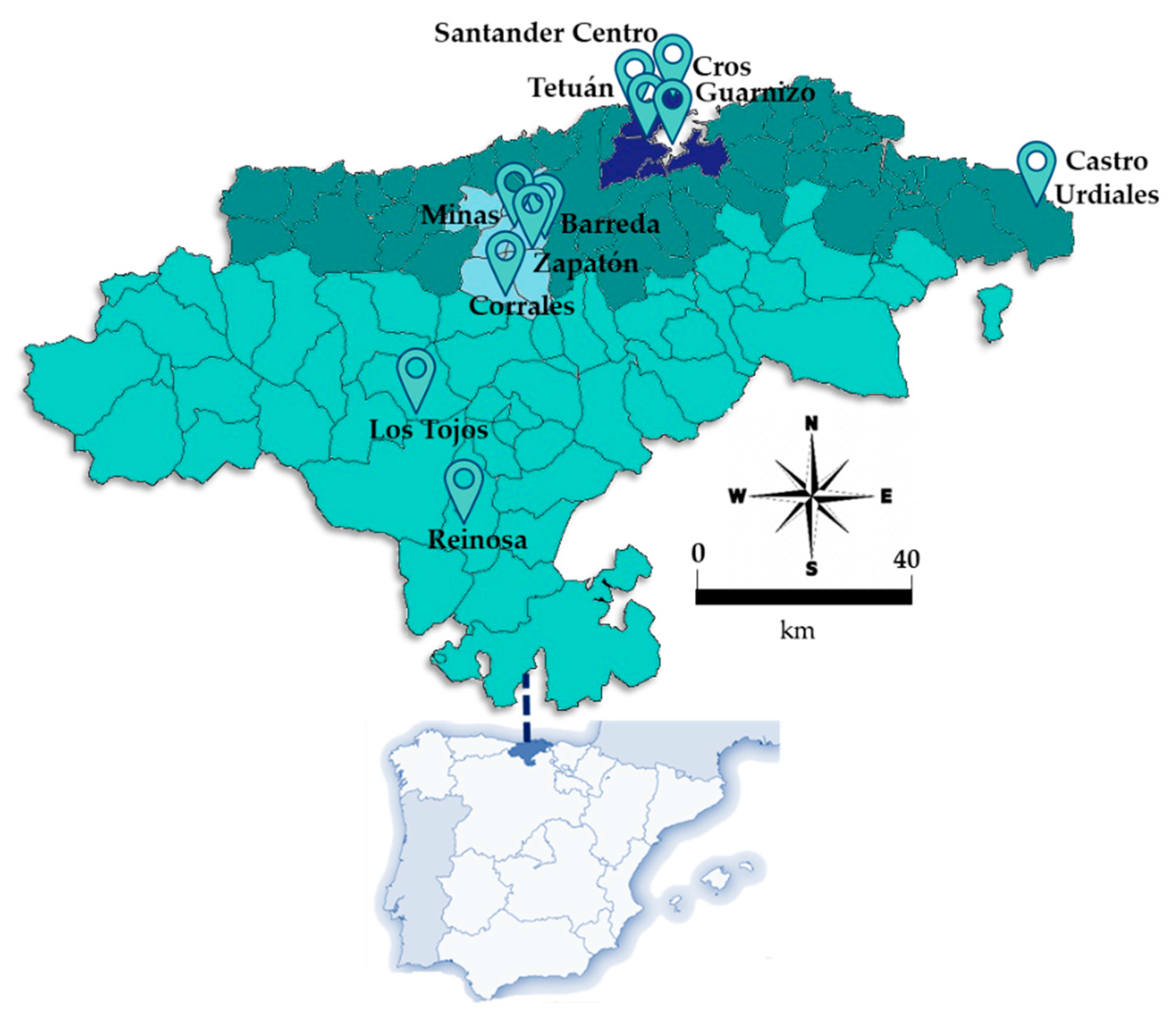


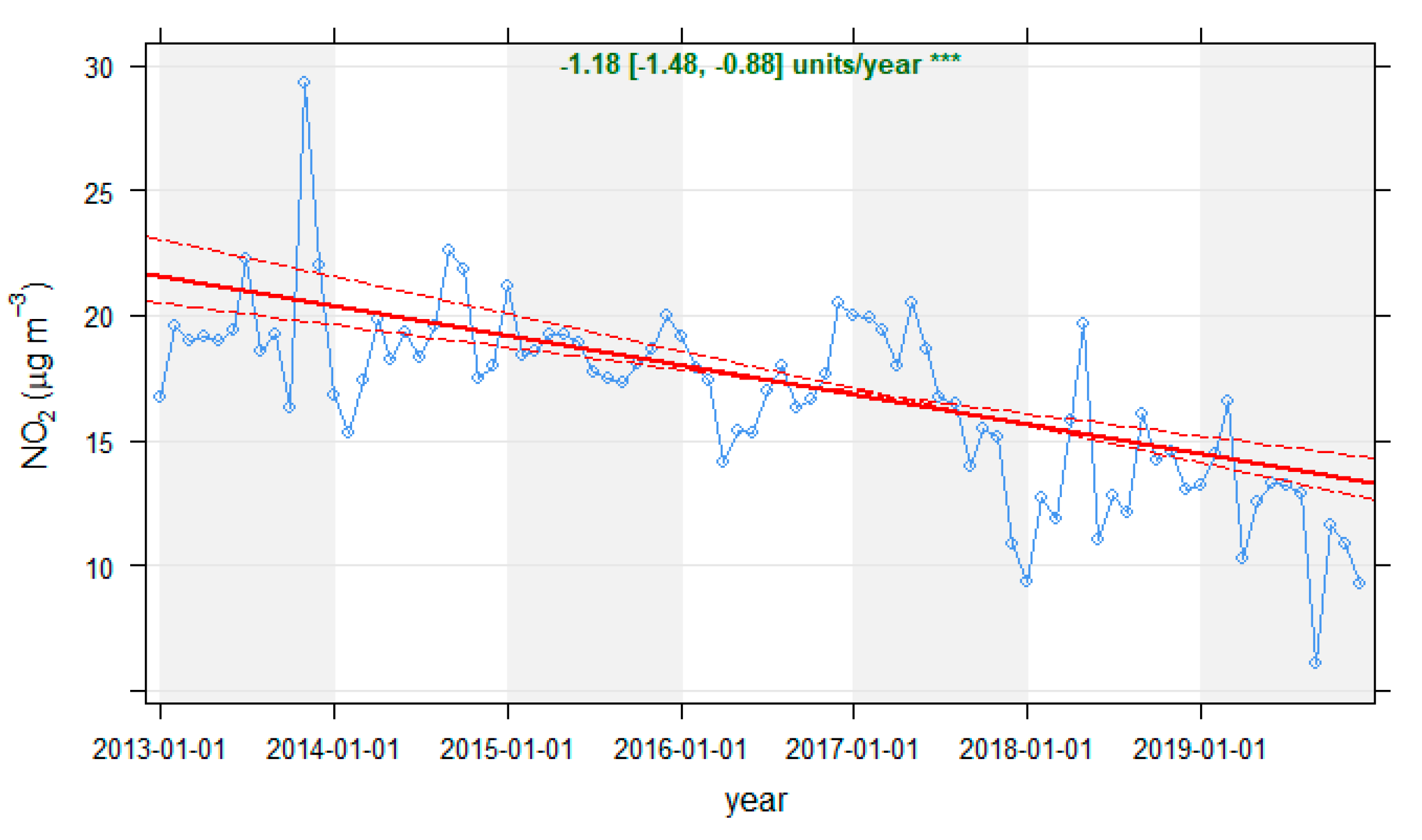
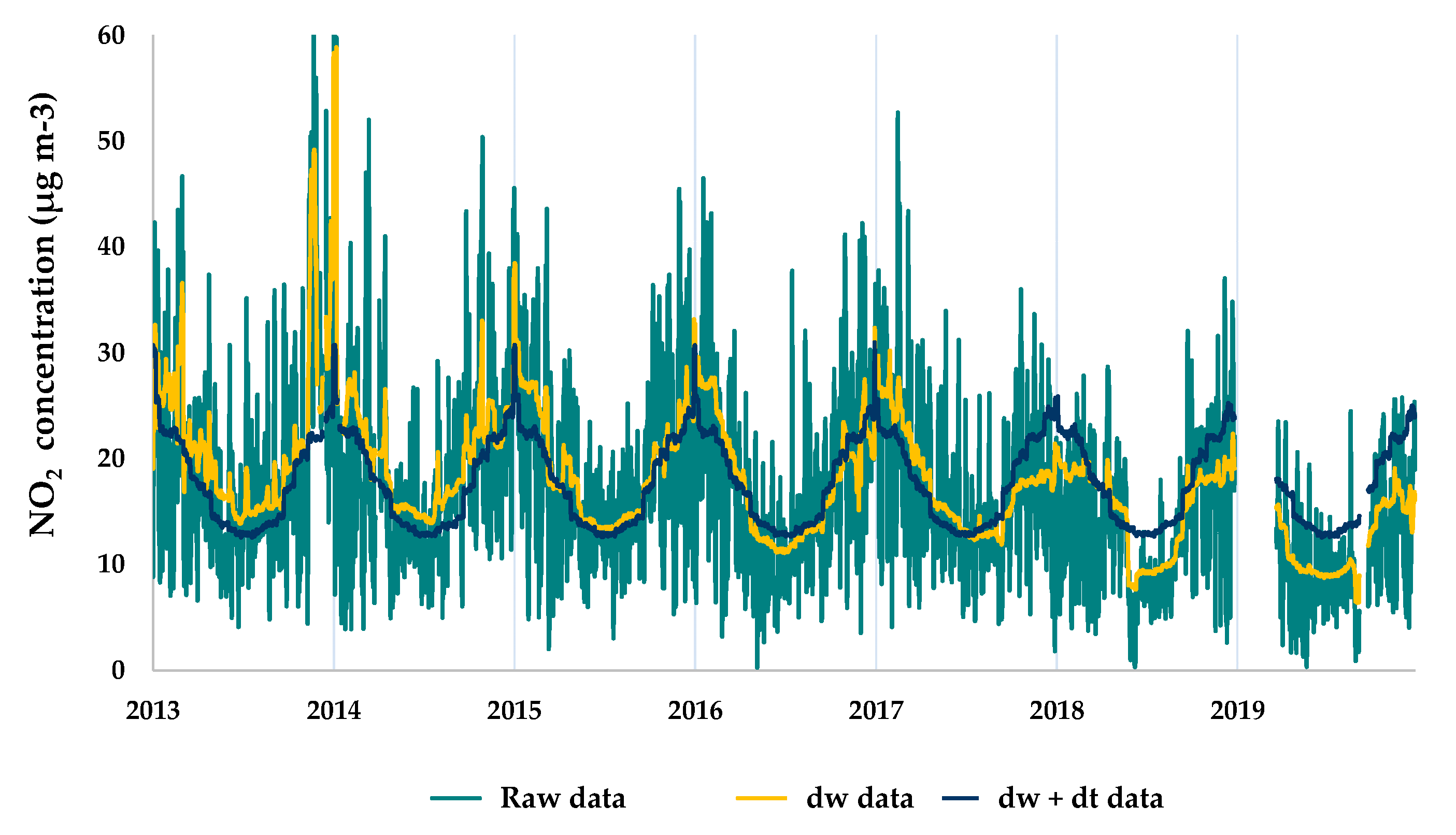

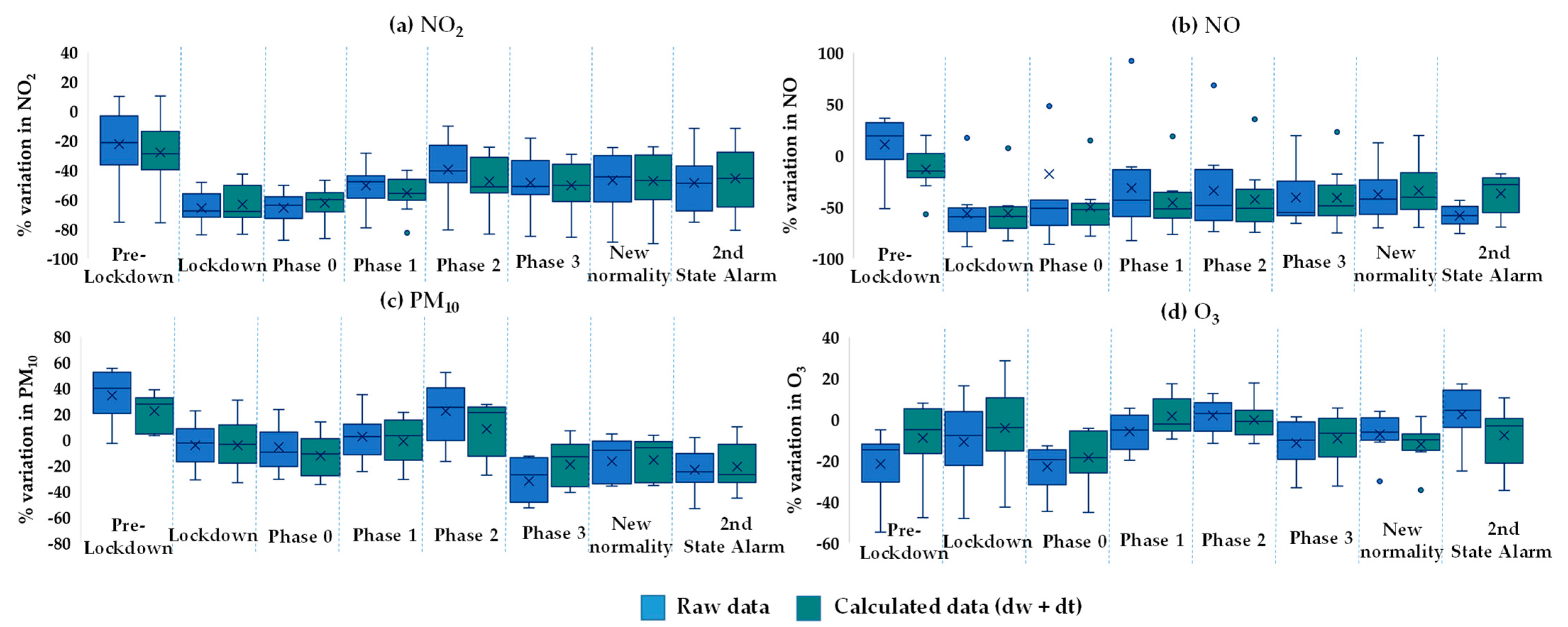
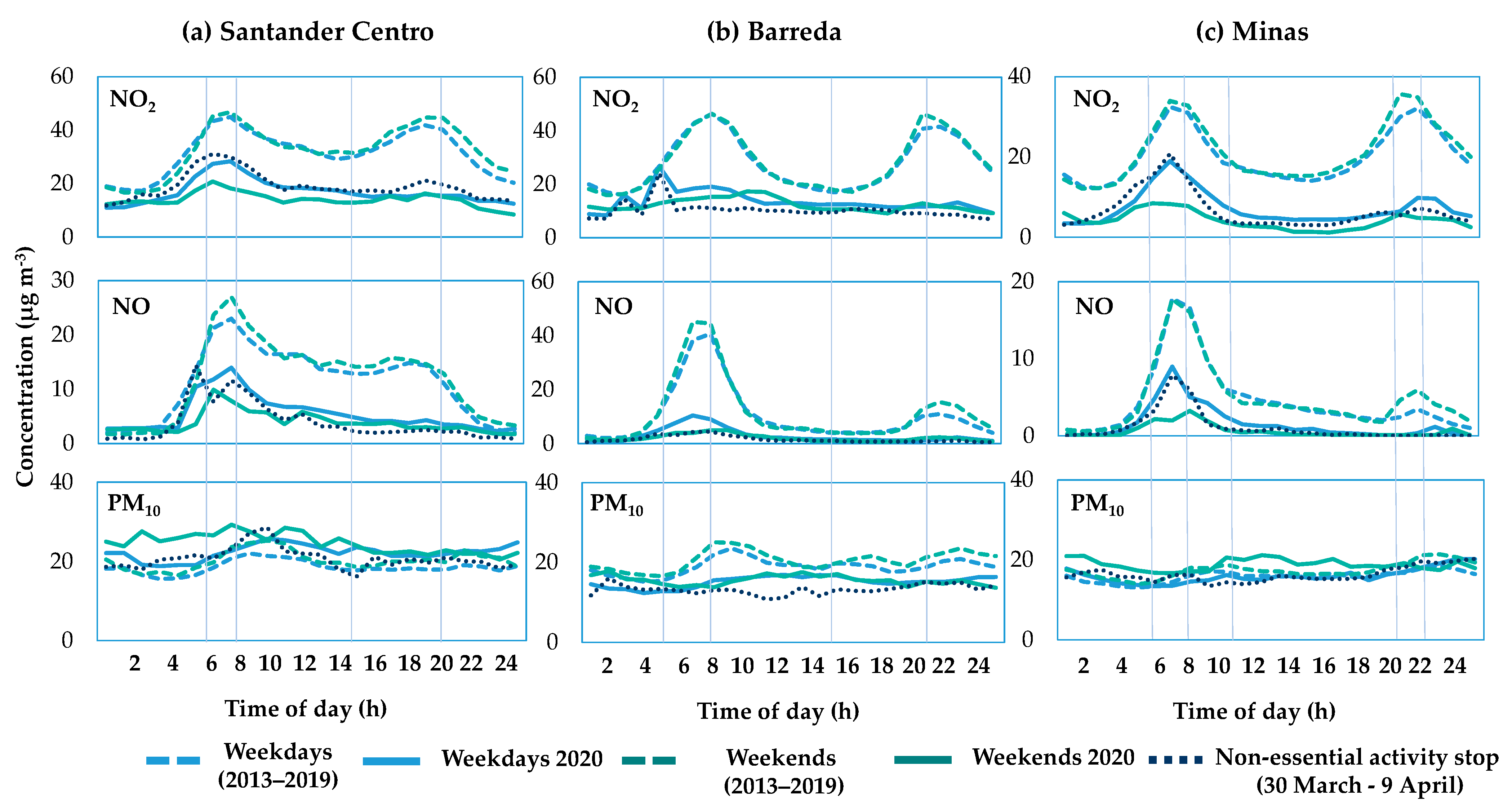
| Site | Code | Type | NO2 | NO | PM10 | O3 | Meteorology * |
|---|---|---|---|---|---|---|---|
| Castro Urdiales | es1578a | Urban background | ✔ | ✔ | ✔ | ✔ | ✔ |
| Corrales | es1579a | Industrial | ✔ | ✔ | ✔ | ✔ | ✔ |
| Guarnizo | es1576a | Industrial | ✔ | ✔ | ✔ | ✔ | ✔ |
| Cros | es1577a | Industrial | ✔ | ✔ | ✔ | ✔ | ✘ |
| Reinosa | es1530a | Urban background | ✔ | ✔ | ✔ | ✔ | ✔ |
| Santander Centro | es1580a | Traffic | ✔ | ✔ | ✔ | ✘ | ✘ |
| Tetuán | es1529a | Urban background | ✔ | ✔ | ✔ | ✔ | ✘ |
| Zapatón | es1038a | Urban background | ✔ | ✔ | ✔ | ✔ | ✘ |
| Barreda | es1037a | Traffic | ✔ | ✔ | ✔ | ✘ | ✘ |
| Minas | es1039a | Traffic | ✔ | ✔ | ✔ | ✘ | ✘ |
| Los Tojos | es1531a | Rural | ✔ | ✔ | ✔ | ✔ | ✔ |
| Site/Pollutant | Pre-Lockdown | Lockdown | Phase 0 | Phase 1 | Phase 2 | Phase 3 | New Normality | 2nd State of Alarm | |||||||||
|---|---|---|---|---|---|---|---|---|---|---|---|---|---|---|---|---|---|
| Raw | dwdt | Raw | dwdt | Raw | dwdt | Raw | dwdt | Raw | dwdt | Raw | dwdt | Raw | dwdt | Raw | dwdt | ||
| Santander | NO2 | +3.2 | −2.3 | −48.4 | −42.8 | −60.4 | −55.8 | −45.8 | −51.5 | −23.7 | −32.4 | −35.8 | −37.7 | −50.4 | −49.6 | −66.8 | −62.1 |
| NO | +13.6 | −18.8 | −59.1 | −62.1 | −43.4 | −48.1 | −38.4 | −46.3 | −73.9 | −63.8 | −58.0 | −56.8 | −44.8 | −40.9 | −64.3 | −62.3 | |
| PM10 | +52.1 | +38.6 | −2.7 | −2.2 | +4.0 | −5.3 | +11.5 | +5.8 | +44.6 | +21.9 | −15.1 | −2.3 | +4.3 | −0.3 | −10.9 | −1.6 | |
| Barreda | NO2 | +9.9 | +10.1 | −56.1 | −45.3 | −50.4 | −58.8 | −58.7 | −58.5 | −43.1 | −52.1 | −44.3 | −49.1 | −46.8 | −49.5 | −49.5 | −48.4 |
| NO | +29.2 | +1.5 | −77.0 | −69.6 | −51.0 | −58.3 | −42.5 | −52.3 | −28.1 | −42.0 | −18.9 | −36.7 | −27.3 | −27.5 | −47.1 | −38.7 | |
| PM10 | −2.9 | +3.0 | −31.2 | −33.4 | −30.7 | −34.9 | −24.7 | −30.9 | −16.9 | −27.5 | −49.4 | −41.0 | −29.9 | −30.5 | −33.1 | −28.0 | |
| Minas | NO2 | −14.9 | −20.3 | −68.8 | −69.8 | −71.9 | −67.7 | −45.8 | −55.5 | −44.9 | −52.1 | −51.5 | −51.8 | −42.5 | −44.7 | −48.0 | −30.4 |
| NO | +11.7 | −4.6 | −72.9 | −72.6 | −76.9 | −67.4 | −54.1 | −59.2 | −55.5 | −52.0 | −57.0 | −48.0 | −44.6 | −40.8 | −62.3 | −29.9 | |
| PM10 | +20.6 | +14.2 | −12.8 | −18.2 | −21.7 | −28.0 | −15.2 | −19.8 | −0.7 | −12.9 | −47.0 | −38.2 | −35.4 | −35.6 | −31.7 | −27.0 | |
| Median | NO2 | +3.2 | −2.3 | −56.1 | −45.3 | −60.4 | −58.8 | −45.8 | −55.5 | −43.1 | −52.1 | −44.3 | −49.1 | −46.8 | −49.5 | −49.5 | −48.4 |
| NO | +13.6 | −4.6 | −72.9 | −69.6 | −51.0 | −58.3 | −42.5 | −52.3 | −55.5 | −52.0 | −57.0 | −48.0 | −44.6 | −40.8 | −62.3 | −38.7 | |
| PM10 | +20.6 | +14.2 | −12.8 | −18.2 | −21.7 | −28.0 | −15.2 | −19.8 | −0.7 | −12.9 | −47.0 | −38.2 | −29.9 | −30.5 | −31.7 | −27.0 | |
Publisher’s Note: MDPI stays neutral with regard to jurisdictional claims in published maps and institutional affiliations. |
© 2021 by the authors. Licensee MDPI, Basel, Switzerland. This article is an open access article distributed under the terms and conditions of the Creative Commons Attribution (CC BY) license (https://creativecommons.org/licenses/by/4.0/).
Share and Cite
Ceballos-Santos, S.; González-Pardo, J.; Carslaw, D.C.; Santurtún, A.; Santibáñez, M.; Fernández-Olmo, I. Meteorological Normalisation Using Boosted Regression Trees to Estimate the Impact of COVID-19 Restrictions on Air Quality Levels. Int. J. Environ. Res. Public Health 2021, 18, 13347. https://doi.org/10.3390/ijerph182413347
Ceballos-Santos S, González-Pardo J, Carslaw DC, Santurtún A, Santibáñez M, Fernández-Olmo I. Meteorological Normalisation Using Boosted Regression Trees to Estimate the Impact of COVID-19 Restrictions on Air Quality Levels. International Journal of Environmental Research and Public Health. 2021; 18(24):13347. https://doi.org/10.3390/ijerph182413347
Chicago/Turabian StyleCeballos-Santos, Sandra, Jaime González-Pardo, David C. Carslaw, Ana Santurtún, Miguel Santibáñez, and Ignacio Fernández-Olmo. 2021. "Meteorological Normalisation Using Boosted Regression Trees to Estimate the Impact of COVID-19 Restrictions on Air Quality Levels" International Journal of Environmental Research and Public Health 18, no. 24: 13347. https://doi.org/10.3390/ijerph182413347
APA StyleCeballos-Santos, S., González-Pardo, J., Carslaw, D. C., Santurtún, A., Santibáñez, M., & Fernández-Olmo, I. (2021). Meteorological Normalisation Using Boosted Regression Trees to Estimate the Impact of COVID-19 Restrictions on Air Quality Levels. International Journal of Environmental Research and Public Health, 18(24), 13347. https://doi.org/10.3390/ijerph182413347







